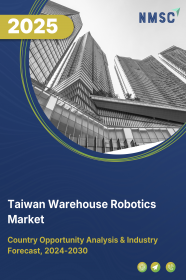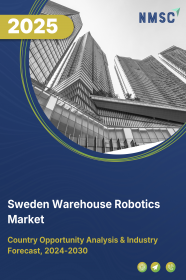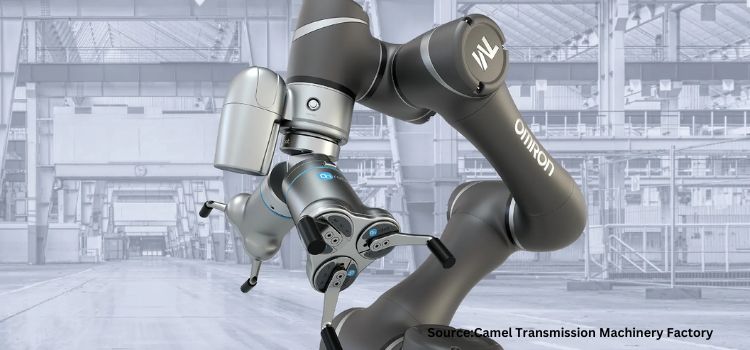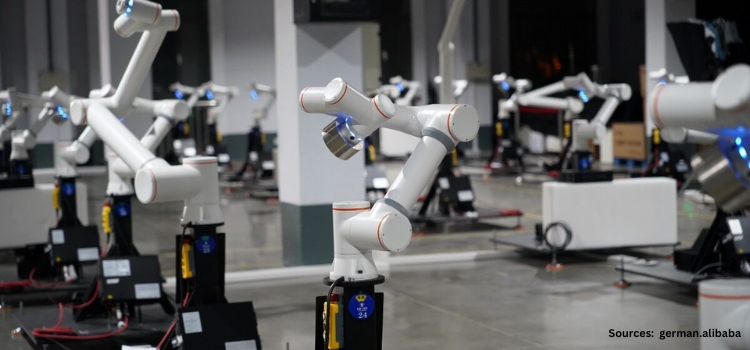
Thailand Warehouse Robotics Market by Type (Automated Guided Vehicles (AGVs), Autonomous Mobile Robots (AMRs), Articulated Robots, & Others), by Offering (Hardware, Software, & Services), by Payload Capacity (Less than 100 KG, 101-200 KG, 201-500 KG, & Others), by Application (Palletizing and Depalletizing, Sorting and Packaging, Picking and Placing, & Transportation) and by End-User (E-commerce, Automotive, Food & Beverages, & Others) – Opportunity Analysis and Industry Forecast, 2025–2030
Industry: Semiconductor & Electronics | Publish Date: 08-Apr-2025 | No of Pages: 218 | No. of Tables: 176 | No. of Figures: 125 | Format: PDF | Report Code : SE3174
US Tariff Impact on Thailand Warehouse Robotics Market
Trump Tariffs Are Reshaping Global Business
Thailand Warehouse Robotics Market Overview
The Thailand Warehouse Robotics Market size was valued at USD 23.2 million in 2024, and is predicted to reach USD 78.8 million by 2030, at a CAGR of 21.5% from 2025 to 2030.In terms of volume, the market size was 1.23 thousand units in 2024 and is projected to reach 4.41 thousand units by 2030, with a CAGR of 22.5% from 2025 to 2030.
Thailand’s expansion of the e-commerce industry helps to fuel for warehouse robotics market and also. Automated solutions such as robotic pickers, automated guided vehicles, and autonomous mobile robots help solving workforce gaps by organizing inventory management, order fulfilment, and management of the Material.
However, large investment costs increasing the expenses associated with robotics is one of the important factors stopping the growth limit the widespread movement of warehouse robotics, reducing overall the Thailand warehouse robotics market growth in the region. On the contrary, introduction of artificial intelligence in the warehouse robotics market creates future option for the market.
E-Commerce Growth Propels the Expansion of Thailand Warehouse Robotics Industry
Increased e-commerce business driven by expansion in internet penetration and growth in online purchasing, is driving the Thailand warehouse robotics market demand for accurate warehousing solutions. With companies expanding to meet fast delivery expectations and handle large order volumes increases. The E-Commerce Association estimated that the e-commerce market value of the country will grow to $26.5 billion in 2023 from $23.4 billion in 2022 with estimates pointing towards additional growth to $32 billion by 2025. This rapid growth of is speeding up the implementation of warehouse robots allowing companies to control the efficiency of operations and meet increased consumer needs.
Rise in Workforce Costs Propels the Thailand Warehouse Robotics Market Trends
Thailand is maintaining wage regulations, leading to rising workforce costs across various industries. As there is rise in expenses of labour, enterprises are adapting to warehouse robotics to manage operations, less dependence on manual workforce, and manage accuracy. Robotics allow warehouses to carry out logistics work with greater accuracy and speed that decreases the long-term operational costs.
As per Ministry of Labour, in January 2025, Thailand's Wage Committee approved a new minimum wage structure. The wage adjustment is expected to further drive the adoption of warehouse robotics in Thailand, as businesses seek to maintain profitability and operational efficiency amidst rising labour costs
High Investment Costs Associated with Robotics Restraints the Thailand Warehouse Robotics Market Expansion
The application of warehouse robotics in Thailand is massively hindered by the high initial investment costs related with these complex systems. Enterprises must assigned healthy capital not only for purchasing robotic tools but also for integrating these systems with already existing warehouse infrastructure.
Moreover, the ongoing finances related to software updates, employee training, and routine maintenance further add to the financial load. For small and medium-sized enterprises, which form a vital part of logistics and warehousing industry, these costs often over burden the perceived benefits, making it problematic to manage such investments. As a result, the large expenses barrier holdback the widespread adoption of warehouse robotics, slowing down the overall market growth.
Introduction of Artificial Intelligence Creates Future Option for the Market
The addition of artificial intelligence in warehouse robotics is expected to play a major role allowing growth opportunity for the market in the future. AI induced solutions improves decision making, optimize inventory management and improve the accuracy and speed of operations that helps warehouses to become more accurate and adaptable.
As such in January 2025, Nvidia disclosed new AI development tools aimed at improving the potential of autonomous robots and vehicles. These models are mad to create synthetic data and simulate physical interactions, allowing developers to create designed templates for testing their AI systems before real-world.
These progresses will focus on the transformative potential of AI in warehouse robotics, paving the way for smarter, more lively and highly efficient warehouse operations that meet the future demands of modern supply chains.
Competitive Landscape
The promising key players operating in the Thailand warehouse robotics industry includes ABB Ltd., Omron Corporation, KUKA AG, Fanuc Corporation, JBT Corporation, Teradyne Inc., Zebra Technologies, Dematic, Honeywell International Inc, Daifuku Co. Ltd., Murata Machinery, Ltd., YASKAWA ELECTRIC CORPORATION, Toshiba Corporation, SSI Schaefer, and others.
Thailand Warehouse Robotics Market Key Segments
By Types
-
Automated Guided Vehicles (AGVs)
-
Laser Guidance
-
Magnetic Guidance
-
Optical Tape Guidance
-
Vision Guidance
-
Others
-
-
Autonomous Mobile Robots (AMRs)
-
Tow Vehicle
-
Tug Vehicle
-
Unit Load Vehicle
-
Pallet Truck
-
Forklift Vehicle
-
Other Type
-
-
Articulated Robots
-
Collaborative Robots
-
Scara Robots and Cylindrical Robots
-
Others
By Offering
-
Hardware
-
Software
-
Warehouse Management System (WMS)
-
Warehouse Execution System (WES)
-
Warehouse Control System (WCS)
-
-
Services
By Payload Capacity
-
≤ 100 KG
-
101-200 KG
-
201-500 KG
-
501-1000 KG
-
1001-2000 KG
-
2001-5000K
-
More than 5000 KG
By Application
-
Palletizing and depalletizing
-
Sorting and Packaging
-
Picking and Placing
-
Transportation
By End User
-
E-commerce
-
Automotive
-
Food & Beverages
-
Pharmaceutical
-
Chemical and Materials
-
Semiconductor and Electronics
-
Others
Key Players
-
ABB Ltd.
-
Omron Corporation
-
KUKA AG
-
Fanuc Corporation
-
JBT Corporation
-
Teradyne Inc.
-
Zebra Technologies
-
Dematic
-
Honeywell International Inc
-
Daifuku Co., Ltd.
-
Murata Machinery, Ltd.
-
YASKAWA ELECTRIC CORPORATION
-
Toshiba Corporation
-
SSI Schaefer
REPORT SCOPE AND SEGMENTATION:
|
Parameters |
Details |
|
Market Size Value in 2024 |
USD 23.2 million |
|
Revenue Forecast in 2030 |
USD 78.8 million |
|
Value Growth Rate |
CAGR of 21.5% from 2025 to 2030 |
|
Market Volume in 2024 |
1.23 thousand units |
|
Unit Forecast in 2030 |
4.41 thousand units |
|
Volume Growth Rate |
CAGR of 22.5% from 2025 to 2030 |
|
Analysis Period |
2024–2030 |
|
Base Year Considered |
2024 |
|
Forecast Period |
2025–2030 |
|
Market Size Estimation |
Million (USD) |
|
Market Volume Estimation |
Thousand units |
|
Growth Factors |
|
|
Companies Profiled |
14 |
|
Available for 10 companies |
Available for 10 companies |
|
Customization Scope |
Free customization (equivalent up to 80 working hours of analysts) after purchase. Addition or alteration to country, regional, and segment scope. |
|
Pricing and Purchase Options |
Avail customized purchase options to meet your exact research needs. |

















 Speak to Our Analyst
Speak to Our Analyst





















